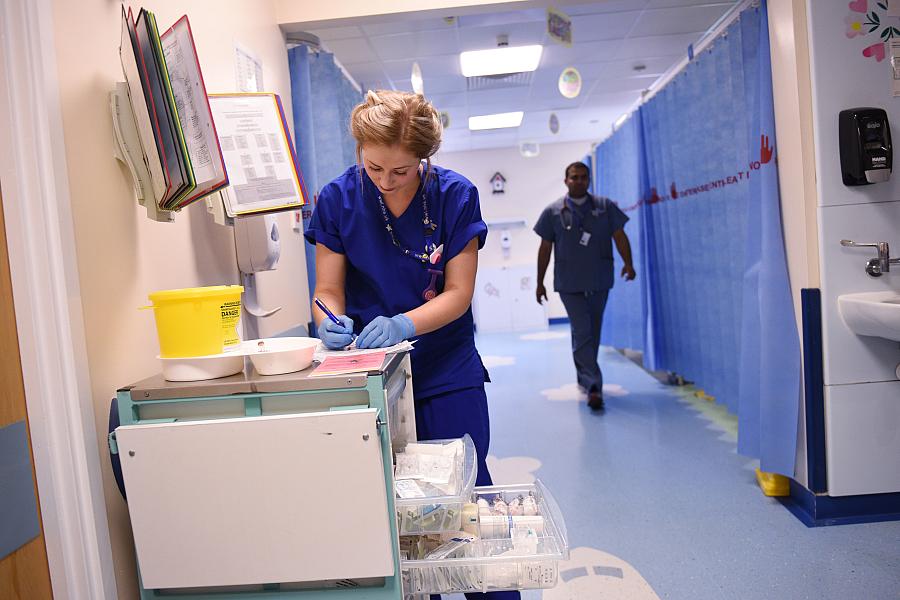‘No-brainer’ program starts treatment for opioid addiction in the hospital

Dr. Hannah Snyder still vividly remembers the patient, addicted to opioids and hospitalized for “incredibly severe” infections up and down his spine.
He needed antibiotics and surgery, but he was vomiting and shaking so much he struggled to stay in the hospital. He had already left hospitals three times before, without finishing treatment as the opioid withdrawal symptoms ravaged his body.
“He said: ‘I want to get my abscesses treated but I’m just so uncomfortable,’” Snyder said.
This time, though, he had entered a hospital participating in Project SHOUT, a California-based program that helps clinicians start and maintain patients on addiction treatment while they’re hospitalized. Even though such patients are frequently hospitalized, they are often treated for their immediate medical condition, not the underlying addiction — something health experts say is a missed opportunity that leaves people at risk for complications and future overdose.
“What they’re doing is critically important,” said opioid addiction policy expert Dr. Andrew Kolodny, co-director of Opioid Policy Research at Brandeis University. “Seeing that they have easy access to treatment while in a hospital bed is a no-brainer. We should be doing this everywhere.”
This growing California effort coincides with recent legislative attention on the national opioid crisis, which claims 115 American lives a day. Just last week, the House and Senate came to an agreement on bipartisan opioid legislation that expands inpatient treatment and access to buprenorphine, a drug used to treat the addiction.
Starting treatment in the hospital
Patients with opioid addiction frequently cycle in and out of hospitals. They’re treated for overdoses, skin infections or heart problems. Too often, though, they only receive care for their immediate medical problem.
But they often experience such powerful withdrawal symptoms that they leave the hospital against medical advice, sometimes so desperate to stop the discomfort that they flee the hospital with IV tubes still attached to their bodies, doctors say. As a result, they often do not finish antibiotic treatments or undergo potentially life-saving surgeries.
California’s Project SHOUT provides clinicians — from hospitalists to maternity-care providers — with guidelines to start and keep patients on medications such as methadone, which can help withdrawal symptoms, and buprenorphine, an anti-addiction medication. Once the patient is ready to leave the hospital, providers connect them to outpatient care as quickly as possible, such as a primary care clinic or an opioid treatment clinic, for follow-up visits. Specialists from the University of California, San Francisco (UCSF) offer webinars, coaching, toolkits and protocols to help providers through the process.
As of August, more than 200 hospitals nationwide and 60 hospitals in California have taken part in educational events, according to project organizers. While Project SHOUT doesn’t have data on outcomes yet, a 2015 JAMA-published study found that addicted patients who received buprenorphine in the emergency department “significantly increased engagement in formal addiction treatment” and “reduced self-reported illicit opioid use.”
The hospital-based effort might sound, as Kolodny put it, “a no-brainer.” But addressing addiction while someone is hospitalized doesn’t always happen for several reasons. For one, there’s the misperception that you have to be an addiction treatment center to start these treatments, Snyder said. Some doctors might be concerned about whether the patient can find somewhere to continue care after they’re discharged. Others doctors may hesitate to start addiction treatment because they worry patients aren’t invested in their own sobriety.
“The argument we make is: We want to meet patients where they’re at,” Snyder said. “Sometimes, the hospital is where they’re at. This is a moment for change.”
‘Any door is the right door’
As Project Shout enters its second year, there’s growth and change ahead. The project, which initially started as a joint effort between the California Health Care Foundation and UCSF, is poised to join forces with ED-BRIDGE, an organization doing similar work in the emergency department.
“Any door is the right door,” Snyder said, referring to the program’s philosophy. “We want to bring addiction treatment to them.”
That’s not the say the approach is without obstacles. Snyder acknowledged there is some concern that starting the treatment in the hospital setting will add more work to already overworked providers.
But Snyder said many doctors are eager for a new approach, particularly those who have too often experienced patients leaving the hospital against medical advice due to withdrawals, or who have seen the same patients repeatedly admitted for substance abuse.
Another big challenge is ensuring a patient can easily continue treatment once they leave the hospital setting, Kolodny said. There are not always outpatient clinics with availability or some might require specific insurance.
Kolodny said this emerging trend of initiating addiction medication while a patient is hospitalized is slowly catching on throughout the country, though it’s still far from common.
“If we can get there, it’s a game changer,” he said. “Right now, there’s a missed opportunity … When we don’t get them started on buprenorphine, we’re missing an opportunity to save a life.”
(Photo: Oli Scarff/AFP/Getty Images)

